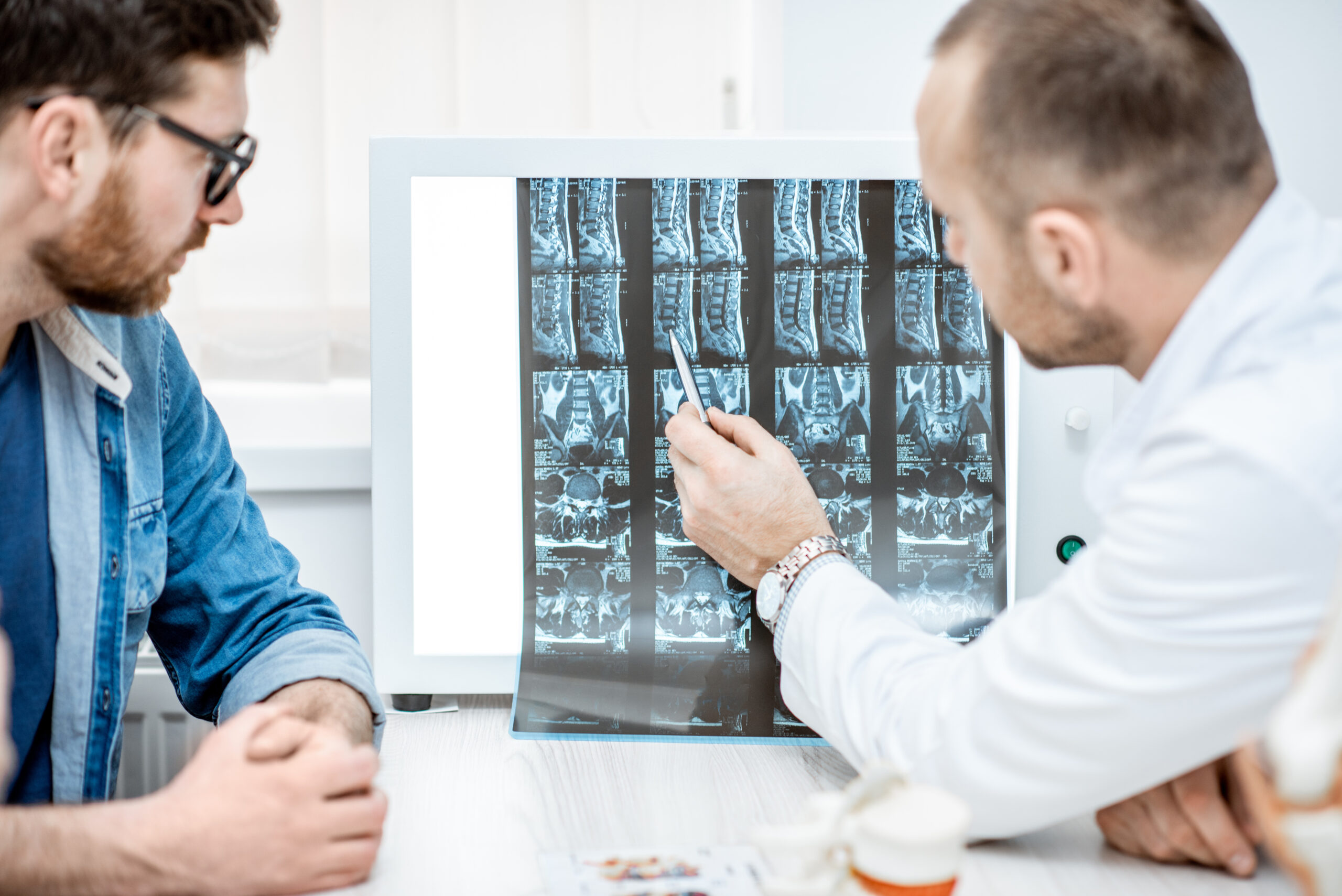
The spine is made up of 33 stacked vertebrae starting at the top of your neck and working down to your hips. In the world of neurosurgery, your vertebrae are divided into two areas: the cervical region near the neck and the lumbar region of the lower back. Your lumbar region carries your weight and connects your upper body to your hips and legs. If you experience pain in the lumbar area of your back, you may have an issue with a particular spinal disc: L5-S1.
Dr. Todd H. Lanman, leading spinal neurosurgeon and founder of the Advanced Disc Replacement Spinal Research Center, has been diagnosing, treating, and performing L5-S1 disc replacement surgeries throughout his career. He is an expert in identifying problems with this joint and helping patients navigate the treatment process. If your doctor is concerned about your L5-S1 disc, here’s what you need to know so you can determine the right treatment path and get back to living life without pain.
What is L5-S1 Disc Replacement?
Every vertebra in your back plays an important role in your mobility, but L5-S1 stands out as a particularly useful joint. L5-S1 is the lumbosacral joint, otherwise known as a transitionary juncture between your lower back and pelvis. L5 refers to your lumbar spine (the fifth bone in your lower back region), while S1 refers to the sacral spine (the first bone in your hips and pelvis). L5-S1 helps transfer loads from your upper body to your legs. It carries more weight than other parts of your spine, which makes it even more valuable.
L5-S1 disc replacement can reduce pain and increase mobility in their joint area. The L5 and S1 vertebrae are protected by a squishy disc that works as a shock absorber between the two bones. Over time, these shock absorbers can wear out, break, or get pushed out of place. When this occurs, patients need an L5-S1 disc replacement. Dr. Lanman will remove the damaged or broken disc and replace it with an artificial model that is more durable and allows for the same range of motion.
L5-S1 disc replacement can help people reduce the pain levels in their lower back. It can also make it easier for them to walk because the L5 vertebra is no longer knocking against its S1 counterpart.
Why L5-S1 Disc Replacement is Successful
There is good news for patients about to undergo an L5-S1 disc replacement procedure: this operation has a high success rate. In a study of 946 patients who went through lumbar total disc replacement, satisfaction rates ranged from 75.5% to 93.3%.
Overall, this is good news for patients who need a L5-S1 disc replacement. The chances of a successful procedure are high – especially if you are receiving the operation by an experienced spinal neurosurgeon, like Dr. Lanman. But why are these lumbar operations so successful? After all, very few surgeries can boast a success rate above 90%.
The world of artificial disc replacement technology is constantly evolving, and surgeons have more advanced tools to work with, which makes the procedure less invasive and reduces the risks of complications. In most cases, Dr. Lanman will enter through your abdomen to complete this procedure and use cutting-edge tools to replace your broken spinal disc. This means your incision will only be an inch or two wide and the whole operation is an outpatient procedure.
Disc replacement is a serious surgery that requires a significant recovery period. However, today’s doctors are able to leverage the latest research and technology to lower the risks of this operation and increase the chances of patient success.
Is L5-S1 Disc Replacement a Good Option for Your Condition?
If you live with lower back pain, you may be a candidate for L5-S1 disc replacement surgery. However, it’s important to seek the advice of an experienced spinal neurosurgeon to determine which lumbar vertebra is causing your pain and, most likely, to try noninvasive treatment options first before considering surgery.
There are a few common conditions that L5-S1 surgery treats. You may be a candidate for this disc replacement procedure if you live with any of the following spinal problems:
- Herniated disc with back and leg pain
- Disc degeneration: your spinal discs have worn out, broken down, or been pushed out of place.
- Grade 1 Degenerative Spondylolisthesis: also known as a slipped vertebrae. This occurs when one of your vertebrae slips out of place and rests on the bone below it.
- Sciatica: pressure on the sciatic nerve causes pain to radiate down your legs and lower back with back pain.
If your doctor has diagnosed any of these conditions then you might be a candidate for L5-S1 disc replacement. Your doctor will likely start with a non-surgical course of treatment, using physical therapy, medication, and hot or cold compresses to reduce your pain levels. However, if your symptoms persist, you may qualify for disc replacement surgery.
Life After a Successful L5-S1 Disc Replacement Surgery
Your L5-S1 disc replacement surgery will only take a few hours; however, the recovery process will last a few months. Here is a basic timeline estimate of what your life will look like immediately after surgery:
- The day after surgery: you should be able to walk around, eat solid food, and complete bowel movements. Your doctor will send you home with medication for the pain and instructions to rest.
- The week following surgery: this is a rest period. You can take walks to help with digestion and improve your mobility. You may not lift any objects heavier than 10-15 pounds (a sack of flour) and should be careful when bending, twisting, and moving in general.
- Two weeks after surgery: you will attend a follow-up appointment with your doctor. You may be cleared to return to light work or your office job.
- Four weeks after surgery: you can begin physical therapy programs and start to regain your flexibility, mobility, and strength.
- Six weeks after surgery: people who work in strenuous jobs that require heavy lifting or manual labor may return to work.
- Three months after surgery: many patients are either completely healed or on their way to recovery at this point.
By the three-month mark, you should notice that your pain levels have decreased and the other symptoms related to your condition have cleared up. Your doctor will let you know when you are cleared to resume your favorite hobbies or return to work completely. Everyone heals differently, so this timeline might be shorter or longer depending on what your body needs.
What You Should Know Before Scheduling A Visit With Your Doctor For L5-S1 Disc Replacement Surgery
L5-S1 is an effective surgery for patients who experience degenerative disc disease in the lumbar region of their spines. It is minimally invasive and comes with a relatively fast recovery time. However, this doesn’t mean you are automatically a candidate for this operation. There are a few things to consider before you schedule an appointment to discuss your surgery.
Know that your doctor will need to run a series of tests to see what your spine looks like and the condition of your protective discs. Just because you have lower back pain doesn’t mean disc replacement is the solution. You may have to meet with your surgeon multiple times before they are confident that an L5-S1 operation is the best route.
You may also need to make changes to your lifestyle ahead of the operation. You will need to prepare for downtime after the surgery and may miss work for some time. Your doctor may also advise you to stop smoking, change your fitness routine, and adjust your diet. If you are passionate about high-impact workouts like CrossFit or running, you may need to switch your fitness style to lower-impact activities like swimming and pilates.
When to Talk to a Spine Surgeon About Treatment
Surgical operations of any kind can be intimidating to patients. This can cause them to delay meeting with a doctor until the pain levels get too high to handle. Delaying treatment is never a good idea. If you have persistent back pain, talk to a doctor. You can meet with a general practitioner who can recommend a spine surgeon near you. If you live in Beverly Hills or Miami, set up an appointment with Dr. Lanman.
Request a Consultation With Dr. Lanman
Problems related to your vertebrae and spinal discs rarely clear up on their own. It is more likely that your back pain will get worse the longer you ignore it or put off treatment. You don’t have to live with lower back pain. If you experience a dull throbbing throughout the day or live with shooting pains in your lower back, request a consultation with Dr. Lanman. He will perform a comprehensive consultation and exam to best identify the issue impacting you and create a customized course of treatment to relieve your pain. Make an appointment today.
Ready to reclaim your life? Get in touch with Dr. Lanman Today.
FOLLOW US ON SOCIAL MEDIA | @ADRSPINE




